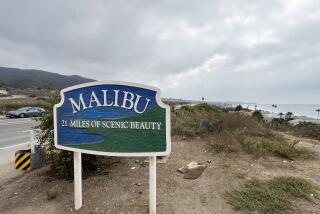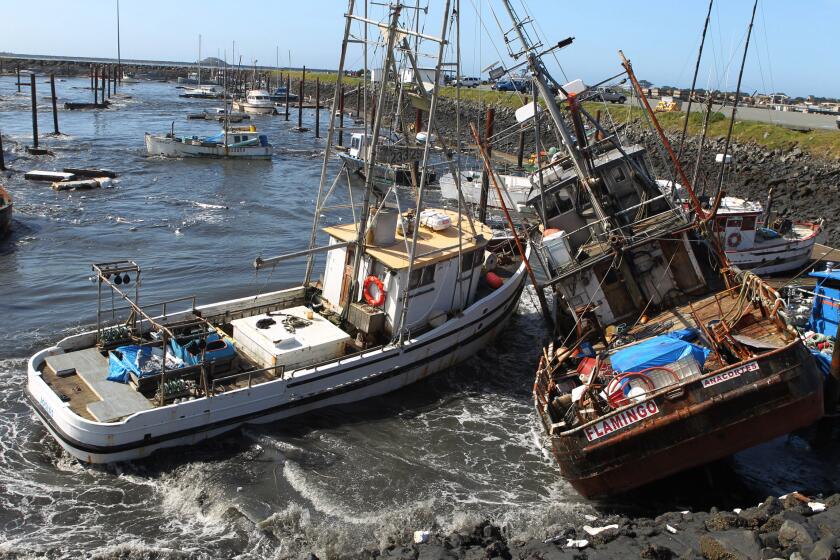Study Probes Uneven Damage in ’94 Quake
- Share via
SAN FRANCISCO — Researchers believe they may have unraveled one of the most persistent mysteries of the 1994 Northridge earthquake--why there was so much damage in parts of Sherman Oaks and Santa Monica, which are farther from the epicenter than other areas that were more lightly damaged.
A geological structure perhaps 3 miles underground focused the shock waves coming from the quake, roughly like a camera lens focuses light, bouncing stronger waves to the Earth’s surface in those two limited areas, the researchers concluded.
The nature of the underground structure was not described.
The fact that the Northridge quake was centered north of both communities is important, said the scientists, who analyzed seismic instrument readings and conducted computer simulations of aftershocks.
Had the quake waves come from any other direction, even from the northwest, the lens effect would not have occurred to the same degree, they said.
Three of the researchers, from UCLA and the Carnegie Institution, reject suggestions that liquefaction of the soil or surface soil composition accounted for any of the localized destruction in those areas.
The other two, from UC Santa Barbara, are not certain that such factors had no role in the disparity. But they too subscribe to the idea that the quake waves were focused by a lens-like effect.
The conclusions of the science professors and postdoctoral students were released Monday on the opening day of the annual convention of the American Geophysical Union, a major scientific conference.
An article has been prepared by the UC Santa Barbara researchers for publication in a scientific journal, Geophysical Research Letters. But the report undoubtedly will be the subject of further comment and analysis.
The focusing effect took place in Sherman Oaks, where the quake waves passed from the sedimentary soil that underlies most of the San Fernando Valley into the subterranean geological structure, said Kim B. Olsen, a research seismologist at UC Santa Barbara who was aided by graduate student Carmen M. Alex.
In Santa Monica, the dividing line was the Santa Monica fault, with the area to the immediate south of it shaken much more severely than the area to the north.
UCLA geophysicist Paul M. Davis, graduate student Hong Liu and Shangxing Gao, a postdoctoral student at the Carnegie Institution, believe the structure that focused and amplified the quake waves from the north had an east-west alignment.
“The fact that [recording] stations at the south of the boundary have higher [shaking] amplitudes may suggest that the southern boundary of the lens structure could be a deeper discontinuity,” they wrote.
Damage surveys after the magnitude 6.7 earthquake indicated that one Sherman Oaks ZIP code, 91403, sustained more than $100 million in damage, while a ZIP code immediately north of it, 91401, sustained only about one-tenth as much, despite being closer to the epicenter.
If verified, the research has major public-policy implications because, contrary to what state geological authorities have indicated, there is very little residents of the affected neighborhoods could have done to prepare for the especially heavy shaking they faced.
There was no way even to know that a geological structure miles under their houses exposed them to added danger.
Hazard zones designated by the state Division of Mines and Geology carry a requirement that builders undertake special geotechnical studies and develop mitigation plans in zones of soil liquefaction and landslides. The heavily damaged Sherman Oaks area is not in such a zone but lies just south of one--where the damage was much less.
The researchers’ conclusions are thus a new indication that such zones identify only part of the threat of particularly heavy shaking.
But they added that the zones of subterranean “discontinuity” that led to the violent shaking in Sherman Oaks and Santa Monica may have been quite small in size. There is no indication, they said, that there is a continuous band of such structures under the Santa Monica Mountains that would generate unusually destructive waves over a wider area, north and south of the mountains.
More to Read
Sign up for Essential California
The most important California stories and recommendations in your inbox every morning.
You may occasionally receive promotional content from the Los Angeles Times.













